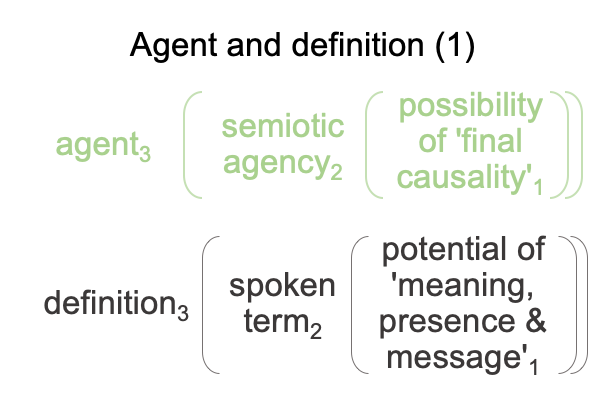0624 Here is a picture of what a sentient cell is “conscious” of, as it appears in a three-level interscope.

0625 Yes, this interscope is both a category-based and a semiotic arrangement. The interscope is not suitable for empirio-schematic inquiry because science investigates actualities. In Semiotic Agency, Sharov and Tonnessen fashion a way to express this interscope in terms of Peirce’s secondness. The S&T noumenal overlay supports empirio-schematic research.
0626 Now, I want to take my examination in a different direction.
In section 13.2.5, the authors claim that non-biological entities cannot become sentient agents. This claim reminds me of the problem faced by biologists, in contrast to physicists and chemists. Semiotic agency2 is composed of both being (relationality) and matter (physicality). Consequently, in order to understand the actuality of semiotic agency2, it2 must be placed in a normal context3 with potential1.
0627 Ironically, the same goes with the spoken word.
Here is a picture.

0628 The juxtaposition is suggestive.
0629 An agent3 and a definition3 both follow the logics of thirdness. The logics of thirdness are exclusion, complement and alignment. Here, one agent3 excludes other agents3. The cell membrane2 plays a role in that exclusion. Similarly, the definition3 of one spoken word2 must exclude the definitions3 of other spoken words2 .
Notably, definition3 does has not have anything like a cell membrane2. Rather, spoken words (parole) constitute a system of differences3. The Greimas square proves useful for teasing out how one spoken word is distinct from other spoken words. (See points 0586 through 0591.)
0630 Semiotic agency2 and a spoken term2 follow the logics of secondness. These logics include the laws contradiction and noncontradiction. If a contradiction exists, then there must be a way to either resolve or formalize the contradiction.
For semiotic agency2, one source of contradiction comes from the hierarchy of agent and subagents, as well as cooperation (and competition) among subagents. If the agent and the subagents have difficulty coordinating2, then the agent3 may fail in regards to its intentions1.
0631 But, what are those intentions1?
Are those intentions1 what the living cell3 is sentient of2?
If so, then I suppose that semiotic agency2 involves being conscious of ‘something’1 and this ‘something’1 could be labeled with spoken words2, as if a living sentient cell could speak.
0632 ‘Final causality’1 and ‘meaning, presence and message’1 follow the logics of firstness. Firstness is inclusive and allows contradictions. So, the intentions1 of an agent3 cohere to the meaning, presence and message1 of a… hmmm… spoken word2?
Uh oh.
The comparison starts to break up. It is as if definition3 is what an agent3 does. An agent3 actualizes something2 that may compare to definition2(3) in order to bring semiotic agency2 into relation with the possibility of ‘final causality’1.
What does this imply?
Is definition2(3) is built into semiotic agency2?
Can spoken words2(2) label what the agent3 is conscious of?
0633 To me, this suggests that final causality1 undergirds the actualities of semiotic agency2 through a passage into meaning, presence and message2(1), as if meaning, presence and message2(1) (now incorporated into semiotic agency2) reify final causality1 for the agent3.
0634 In other words, the agent3 defines2(3) through its life and sentience (SIs and SIe) actualities that it is conscious of2(2) (SVs, SOs, SVe and SOe) by embodying meaning, presence and message2(1) as manifesting the potential of ‘final causality’1.
Here is a picture.

0635 Does this make sense?
The entire nested form that we (humans in our current Lebenswelt) associate with definition3 becomes a characteristic of semiotic agency2. Therefore, all the elements of how to define a spoken word enter into the realm of actuality2. Definition3 gets transubstantiated (a change of category) down to actuality2. Meaning, presence and message1 gets transubstantiated up to actuality2. And, the spoken word2 becomes what the living entity would be conscious of, if it were conscious2.
